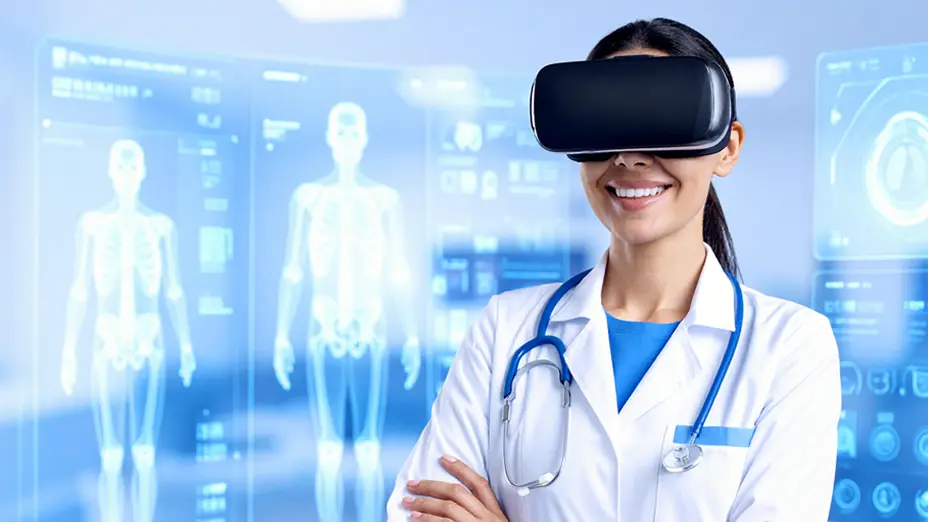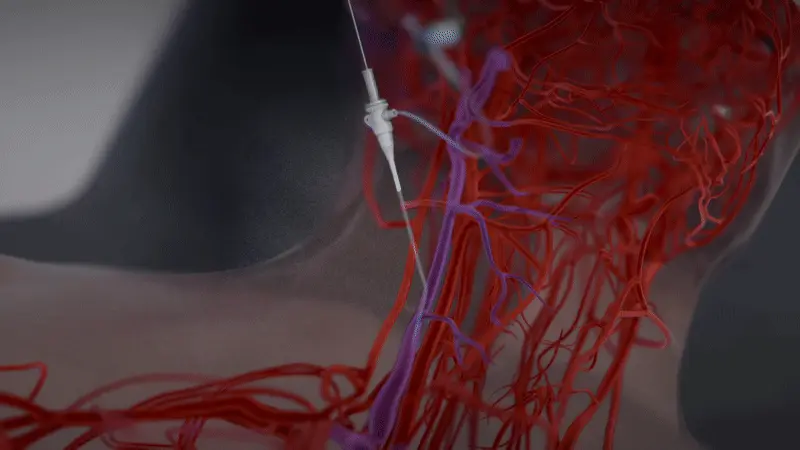
Latest technology trends in the healthcare industry in 2026

Table of contents
Healthcare’s no longer stuck in the reality of old-school paper charts and cold exam rooms. Today, patients can chat with doctors from the comfort of their own homes. Surgeons practice complex procedures in virtual reality (VR) before touching a scalpel. Revolutionary 3D modelling allows for real-time learning and exploration of anatomy. And this isn’t sci-fi. It’s the very tangible future of healthcare, and it’s happening right now. In this article, we’re breaking down the top 10 healthcare technology trends for 2026 that will change the industry. Curious what the future looks like? Let’s take a look.
Why healthcare technology trends matter in 2026
Before we delve into the exciting advancements like VR surgeries, AI diagnostics, and 3D visuals, let’s discuss the various challenges and opportunities that modern digital transformation presents.
The challenges and opportunities of digital transformation
Healthcare is standing at a digital crossroads. On one side: outdated systems, overworked staff, and endless complexity. On the other hand? A wave of emerging healthcare technology trends is ready to make care faster, smarter, and more human, if we’re willing to embrace it.
Challenge #1: Staff burnout and workforce shortages
Nurses and doctors are often stretched thin. Administrative tasks eat into patient time, which increases stress and leads to burnout.
Opportunity: Healthcare automation, such as AI-powered tools, can handle the mundane tasks, from scheduling to charting. With this approach, it’s possible to free up time for actual care, and tech becomes the assistant, not the obstacle.
Challenge #2: Patient trust and data privacy
The more we digitize, the greater the risk of exposing sensitive information. And once trust is broken, it’s hard to earn it back.
Opportunity: Blockchain in healthcare is paving the way for secure and transparent data handling. Patients stay in control of their records, and trust gets rebuilt.
Challenge #3: High cost of innovation
New technology isn’t cheap. And smaller clinics or distant providers often get left behind while big hospitals move forward.
Opportunity: The rise of cloud healthcare solutions and subscription-based platforms makes technology healthcare trends more affordable and scalable.
Challenge #4: Technology that looks good but doesn’t help
Not every new tool improves care. Some of them add more clicks, more training, and more headaches.
Opportunity: The new generation of human-centered design and evidence-based digital health tools is built with clinicians and patients in mind. Simpler interfaces, better UX, and measurable outcomes are not just added features — they’re the result of close collaboration between technology teams, clinical experts, and consultants. Strategic implementation helps ensure these tools improve workflows rather than disrupt them.
What defines a cutting-edge healthcare technology?

In 2026, the best medical technology industry trends improve healthcare through accuracy, accessibility, scalability, and patient impact, but they also share one thing in common: they solve real problems. Let’s look in more detail:
Accuracy: A technology is only valuable if it delivers consistently reliable results. If a diagnostic tool can’t reduce human error or improve decision-making, it won’t add clinical value.
Accessibility: Innovation means little if it’s out of reach. The most effective solutions are those that can be implemented across different settings.
Scalability: Healthcare doesn’t operate on a small scale. Can the tool handle thousands of patients, or multiple hospital systems, or even regional networks?
Patient impact: Does it ultimately make people healthier, safer, or more empowered? If the answer is no, it doesn’t matter how advanced the technology is.
Top 10 healthcare technology trends in 2026
Some innovations are already reshaping how we deliver care, while others are just starting. Here are the top healthcare IT trends making waves in 2026.
1. Immersive AR/VR for medical training and patient care

Immersive AR/VR in healthcare adds significant value to medical education and patient interaction. It’s no longer just a futuristic gimmick as extended reality helps surgeons rehearse complex procedures, lets students study anatomy without touching a cadaver, and gives patients a clear, interactive view of what’s happening inside their bodies. In other words, such tools bridge the gap between knowledge and experience, offering spatial understanding that traditional methods can’t match.
VOKA – A tech company that specializes in 3D medical animation and AR/VR solutions for healthcare, pharma, and medical education.
Services:
AR solutions for healthcare
VR solutions for healthcareOsso VR – A surgical training platform using VR to simulate real procedures for residents and practicing surgeons.
License: Enterprise, academic
https://ossovr.comMedical Holodeck – Multi-user platform for surgical planning and medical team collaboration.
License: Personal, commercial, educational, clinical
https://medicalholodeck.com
2. AI and machine learning in diagnostics
No human can read every medical journal, scan every CT, and recall every rare disease. But AI is built for exactly that. AI-powered diagnostics are helping doctors detect abnormalities earlier, faster, and sometimes more accurately than traditional methods. From radiology to dermatology, machine learning models spot patterns that might slip past even the most seasoned specialist. But that’s not to say clinicians are in danger of being replaced; it simply shows us how AI can provide reliable second opinions in real-time.
Aidoc – an AI-powered platform that detects acute abnormalities in medical imaging.
License: Commercial, custom integrations available
https://www.aidoc.comPathAI – Machine learning models for pathology analysis to improve diagnostic accuracy.
License: Commercial
https://www.pathai.comGoogle DeepMind’s AlphaFold – AI that analyzes medical images and scans, supporting early-stage diagnostics and drug discovery.
License: Open-source for non-commercial use
https://www.deepmind.com/research/highlighted-research/alphafold
3. 3D medical visualization and animation for medical communication
Simple images are obviously insufficient to capture the complexity of the human body. Whether you're refreshing anatomy and physiology or explaining conditions to patients, 3D medical visualization makes anatomy and pathology more transparent and precise. These tools don’t just show the body but let you explore it. From rotating organs to zooming into microscopic pathology in motion, these tech innovations are indeed practical.
VOKA 3D Anatomy & Pathology – Offers immersive, high-definition 3D models for education, training, and patient explanation.
License: Commercial, with academic access optionsBioDigital Human – Interactive 3D platform visualizing the human body, conditions, and treatments.
License: Personal with limited free version; institutional and enterprise paid plansVisible Body – Comprehensive 3D medical illustration library used for education and clinical reference.
License: Student, professional, institutional use
4. Telemedicine and remote monitoring for better access to care

Traditionally, seeing a doctor means sitting in a waiting room and flipping through outdated magazines. Not anymore. In 2026, telemedicine innovations simplify access to care, from routine check-ups to the management of chronic conditions. This leads to fewer hospitalizations, more personalized care, and better outcomes, especially for people in distant areas or with mobility issues.
Teladoc Health – A global leader in virtual care, offering everything from general medical to mental health and chronic condition support.
License: Subscription, insurance-based.
https://www.teladochealth.comAmwell – A telehealth platform connecting patients with providers for urgent care, therapy, and more.
License: Subscription, insurance-based
https://business.amwell.com/Withings Health Mate – Remote monitoring platform paired with smart scales, BP monitors, and wearables to track patient vitals in real time.
License: Subscription
https://www.withings.com
5. Robotics and automation in surgery for precision and efficiency
Robotics in surgery has become commonplace in ORs as it takes precision to a whole new level, minimizing human error and improving patient outcomes. Meanwhile, automation is stepping in to assist with instrument handling, patient monitoring, and even suturing, giving surgeons more control and fewer distractions.
Intuitive’s da Vinci Surgical System – A widely used robotic platform enabling minimally invasive procedures with enhanced precision.
License: Commercial, hospital installations
https://www.intuitive.com/en-us/products-and-services/da-vinciCMR Surgical Versius – A next-gen, modular robotic surgery system built for flexibility and affordability.
License: Commercial, aimed at hospital adoption
https://cmrsurgical.comROSA by Zimmer Biomet – A robot designed for orthopedic surgeries like knee and brain procedures with real-time data guidance.
License: Commercial
https://www.zimmerbiomet.com
6. Blockchain for secure healthcare data and patient trust
Unfortunately, healthcare data often suffers from a lack of transparency. While records are stored across fragmented systems, it’s the security gaps and limited traceability that pose the greatest risks. In a field like healthcare, that’s simply not acceptable. At this point, blockchain in healthcare emerges as a genuine solution for security, transparency, and control. This technology is used to secure electronic health records, track drug supply chains, and give patients full ownership over their medical data.
MediBloc – A decentralized health information platform that lets patients control their data and share it securely with providers.
License: Commercial
https://medibloc.comTuunio (Solve.Care) – Blockchain platform focused on streamlining healthcare administration and care coordination.
License: Commercial
https://solve.careBurstIQ – A blockchain-enabled data exchange network for healthcare organizations to securely share health data.
License: Commercial
https://burstiq.com
7. Personalized medicine and multiomics for well-tailored treatment
In 2026, there is no one-size-fits-all. Personalized medicine technology is taking center stage, and it’s powered by multiomics, big data, and smart algorithms. Instead of guessing how a patient might respond to a drug or treatment, we now have the tools to tailor care to their unique genetics, lifestyle, and risk factors. From cancer therapies designed around DNA profiles to gene-based predictions for chronic diseases, medicine becomes a custom health strategy.
23andMe Health – A consumer genomics service offering health insights, disease risk reports, and pharmacogenetic data.
License: Starter, advanced
https://www.23andme.comFoundation Medicine – Genomic testing and profiling for cancer treatment personalization.
License: Commercial, clinical use
https://www.foundationmedicine.comTempus – AI-powered precision medicine platform using clinical and molecular data to guide personalized treatment decisions.
License: Commercial, for providers and researchers
https://www.tempus.com
8. Cloud-based healthcare platforms for scalability and collaboration
Healthcare data doesn’t live on a dusty server in a hospital basement anymore. Today, it’s all in the cloud. Cloud healthcare solutions are helping healthcare systems scale faster and share data easily. Need to pull patient records from another clinic, collaborate across departments, or run AI diagnostics without massive on-site hardware? Cloud tech makes it possible and accessible.
Google Cloud Healthcare API – Supports secure data exchange, integration with FHIR/HL7, and scalable analytics in the cloud.
License: Commercial, for developers and providers
https://cloud.google.com/healthcare-apiSalesforce Health Cloud – CRM meets healthcare, offering comprehensive patient views, care coordination tools, and cloud-based engagement.
License: Commercial, B2B
https://www.salesforce.com/products/health-cloud/Amazon HealthLake – A cloud platform designed to aggregate and analyze health data at scale using machine learning.
License: Commercial
https://aws.amazon.com/healthlake
9. Wearable medical devices for real-time health insights
Fitness trackers, such as the Apple Watch or Whoop, have evolved so far beyond counting steps. Wearable medical devices are tracking everything from heart rhythms to oxygen levels, even detecting early signs of illness before symptoms appear. Real-time data enables earlier interventions, more informed treatment plans, and fewer unnecessary hospital visits.
Apple Watch Series 9 – Tracks heart rate, ECG, blood oxygen, and sleep, with alerts for irregular rhythms.
License: Consumer-grade, FDA-cleared ECG feature
https://www.apple.com/apple-watch-series-9BioBeat – Clinical-grade wearables for continuous remote monitoring of vital signs like BP, respiratory rate, and more.
License: Commercial, hospital-grade
https://www.bio-beat.comZio by iRhythm – A discreet wearable patch for long-term heart monitoring and arrhythmia detection.
License: Prescription-based, clinical use
https://www.irhythmtech.com/us/en/solutions-services/irhythm-service/zio-monitor
10. Healthcare cybersecurity innovations for a safer digital future
You can’t go digital without thinking about security, and in healthcare, the stakes are naturally higher. Cybercriminals target healthcare due to the sensitivity of the data that can be exploited: personal details, medical history, insurance info, and even payment records. Thankfully, the industry is finally catching up. From AI-driven threat detection to biometric logins, healthcare systems are locking things down in smarter, faster ways to prevent attacks and data leaks.
Cynerio – an AI-powered platform that protects connected medical devices and hospital IoT systems from real-time threats.
License: Commercial, used in clinical environments
https://www.cynerio.comImprivata – Offers identity and access management solutions tailored for healthcare, including secure SSO and biometric authentication.
License: Commercial, hospital-wide integrations
https://www.imprivata.comClaroty xDome – Cybersecurity platform purpose-built for healthcare, designed to safeguard every cyber-physical system across your environment.
License: Commercial, enterprise-level
https://claroty.com/healthcare-cybersecurity/xdome-for-healthcare
How healthcare technology trends will shape the future
So, what do all these medical technology market trends mean for the future of healthcare? Beyond the hype and headlines, let’s look at where we’re heading.
Greater impact on patient care quality and accessibility
What’s the biggest win from all the latest healthcare technology trends? Patients. They’re getting better care, faster answers, and more control than ever before. Let’s break down how:
Faster, more accurate diagnoses. AI tools and predictive analytics mean less guesswork, fewer misdiagnoses, and quicker action, particularly in critical areas such as cancer, cardiology, and neurology.
Care that comes to you. Telemedicine and remote monitoring enable individuals to receive treatment at home, track chronic conditions in real time, and avoid unnecessary hospital visits.
More transparent communication and understanding. 3D visualizations and immersive AR/VR help patients see what’s happening in their bodies firsthand. No more confusing charts or complicated, term-heavy explanations.
Tailored treatment plans. Thanks to genomics and personalized medicine, patients receive therapies tailored to their unique biology, not just universal treatment protocols.
Greater transparency and data control. Blockchain and cloud platforms provide patients with greater access to their health records and increased control over who has access to them.
All in all, healthcare is becoming more inclusive, more intuitive, and a whole lot more patient-first. Apart from just receiving care, patients understand it, engage with it, and actively participate in decisions about their health. With clearer communication tools and easier access to their data, patients feel more empowered to ask questions and give truly informed consent.
Benefits for healthcare professionals and systems

Healthcare IT industry trends transform life “behind the scenes”, too. For healthcare professionals and systems, these innovations aren’t just nice-to-haves. They help to handle high pressure, even when resources are stretched.
Less admin, more patient time. Automation tools and AI-powered documentation take repetitive tasks off HCPs’ responsibilities. That means fewer clicks, less burnout, and more time spent face-to-face with patients.
More thoughtful decision-making. AI diagnostics, predictive analytics, and integrated electronic health records (EHRs) help clinicians make informed choices quickly and confidently.
Easier collaboration across teams and locations. Cloud platforms and interoperable systems simplify sharing patient data across departments, hospitals, and even borders, in real time and without the fax machine.
Better resource management. From robotic surgery to remote monitoring, tech helps optimize staffing, reduce hospital readmissions, and streamline operations.
A shift toward preventive, value-based care. Wearables, real-time data, and predictive tools support early interventions. This helps healthcare systems pivot from reactive to proactive.
Wrapping up on the latest trends in healthcare technology
The future trends in healthcare technology are already here. From AI diagnostics and immersive 3D visuals to remote patient monitoring, the tools reshaping the industry are practical, powerful, and deeply patient-centered.
For both providers and patients, these innovations mean faster answers, more intelligent decisions, and more personalized care. As the line between digital and clinical continues to blur, one thing is clear: the most innovative technologies are those that make healthcare feel more human.
Table of contents
Thank you for your comment!
Your comment has been submitted for moderation and will be published soon. We'll email you once it’s live.